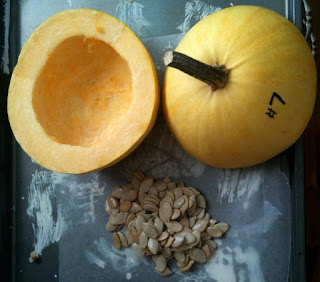Lotta pictures and when I uploaded them the blog application decided to rotate a bunch of them willy nilly, so don't be surprised by the weird camera angles. Anyway, I decided it was about time to cut open some of my pumpkins that have been waiting in the basement. I want to get their seeds dried down for 2016 planting. These are from my hull-less seeded pumpkin project so I have to be careful not to leave them too long or I'll have seeds sprouting inside the pumpkins. These are now quite a few generations down the line from an original cross of 'White Scallop' bush squash and 'Styrian Hulless' naked seeded pumpkin. The first five are my favorite picks from the 2015 population - numbered 1 thru 5 with a Sharpie marker. I also cut open 6 and 7 because number 4 had shells on its seeds and I wanted at least one more good seeded one. Glad I did, because number 6 had an unusually thick flesh which was pretty cool.


Here's a comparison of the flesh color and thickness. The lighting wasn't very good so they all look a little bleached out. Note the thick flesh, I'd mentioned on number 6.
My favorite overall is number 1. Stark white skin (which came from 'White Scallop' squash) and yellowish flesh. High count of plump little hulless seeds.
Bummer... number 4 had hulls (hence the white colored seeds).
Number 5 looks a lot like the 'Styrian Hulless' ancestor. It also has a serious flaw. The seeds have a strong tendency to sprout while still inside the pumpkin. This is something I've been selecting against, so I'll most likely never plant any seeds from this one.
Number 6 with its interesting thick flesh. I should've known by how heavy this guy was! This is a trait I'd like to keep in the population. So since it also has a high number of plump seeds, I'll probably use this one in the future plantings.
Number 7 was another dud - with shells on the seeds.
When all the seeds were safely drying back down in the basement. I put 1, 2 and 3 in the oven and baked them for almost 2 hours. Then I scooped out the flesh and processed it in the food processor.
I put 8 cups in the freezer (2 cup portions in each sandwich bag) to freeze and still had enough puree to be the base for two loaves of squash bread.
I don't generally follow any recipe anymore when I make bread, but this is essentially just white bread made with pumpkin puree in place of the water.



















